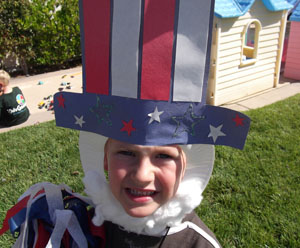Uncle Sam
Tradition holds that the name “Uncle Sam” is connected to a real person by the name of Sam Wilson. Born in Arlington, Massachusetts, in 1768, most of Sam’s childhood would have been during the Revolutionary War. Around 1789, Sam moved to Troy and became a prominent business man who was active in political affairs.

The first recorded account of how the nickname came to be associated with Sam Wilson appeared in the Book of the Navy (1842). The author, John Frost, recalls having read the story elsewhere, most likely in a newspaper, but the source has not been found. The story follows.
During the war of 1812, an army contractor by the name of Elbert Anderson of New York traveled to Troy to purchase barrels of pork and beef from the Wilson meat company. Sam Wilson oversaw a large number of workers who were busily moving barrels for the army. The barrels were apparently marked E.A. – U.S., and when one of the workers asked another fellow employ the meaning of the initials, he was told that they must stand for Elbert Anderson and “Uncle Sam” (clearly a reference to his boss). The joke stuck, and as many of these workers ended up serving in the war, they carried the story with them. (John Frost, The Book of the Navy, D. Appleton & Co., 1842, pp. 297-298).
After extensive research on the topic, historian Albert Matthews believes that though the story of Sam Wilson is plausible, several facts “militate strongly against” it (Matthews, p. 59). For example, (1) there is no known written record of the story until 1842 (almost 30 years after the first use of the term), (2) obituary notices of Sam Wilson make no mention of his connection to the famous nickname, and (3) the name was at first used derisively to refer to the American government.
With the earliest use of the nickname is newspapers came the following explanations: “The letters U. S.,” wrote the Troy Post of September 7, 1813, “on the government wagons . . . are supposed to have given rise to it.” And on October 1, 1813, a writer spoke of “Uncle Sam, the now popular explication of the U.S.” (Matthews, pp. 64-65).
Though the early use of the nickname does not appear to have its origin with Sam Wilson, it is still possible that his workers did indeed use the term to apply to their boss. Sam’s character is made evident in his eulogy (1854):
“[In Business] He prosecuted successfully, at least four distinct kinds of business, employing about 200 hands constantly . . . His tact for managing laborers . . . secured a greater amount of labor than ordinary men. [In Politics] In his political creed, he was strictly Republican and was warmly attached to the Democratic party, and in the election of General Jackson to the Presidency, he took an active part, serving as a standing chairman of the party both at his first and second election. [In Religion] At the age of three score years [60] his mind became deeply imbued with religion, and feeling his responsibility to his Maker, he solemnly dedicated himself to God . . . . His walk and conversation since the solemn transaction, evidenced the sincerity of his profession.”
Sam Wilson was a successful and inspirational leader, the perfect namesake for a national symbol. And as historian Albert Matthews points out: “There is a popular tendency to connect nicknames with persons” (p. 21). In 1961, the U.S. Congress passed a special resolution recognizing Sam Wilson as “the progenitor of America’s national symbol of Uncle Sam.” His birthday, September 13, has been proclaimed “Uncle Sam’s Day” in New York State.
The Evolution of Uncle Sam
The nickname “Uncle Sam” almost certainly originated during the War of 1812. The term was first used by the press in 1813, and ironically, it seems to have been used derisively to refer to the government. It was employed, at least for a year or so, mainly by those who opposed the war (Matthews, p. 23).
By the end of the conflict, as anti-war sentiments subsided, Americans began to use the nickname “Uncle Sam” positively. In a 1831 skit, James Kirke Paulding, an American writer who at one time served as the U.S. Secretary of the Navy, wrote:
“Once upon a time there lived, and still lives, in a country lying far to the west, a famous squire, rich in lands and paper money. Report made him out to be the son of John Bull [a nickname applied to Great Britain], who every one knows has children in all parts of the world. . . John Bull had christened this son of his by the name of Jonathan [the U.S. had long had the nickname Brother Jonathan]; but by and by, when he became a man grown, being a good hearty fellow, about half horse half alligator,” his friends and neighbours gave him the nickname of Uncle Sam; a sure sign that they liked him, for I never knew a respectable nickname given to a scurvy fellow in my life. Be this as it may, his family and all his neighbours at last came to call him nothing else but Uncle Sam; and all his beef, pork, and flour, in fact everything that belonged to him, was marked with a huge U. S., six inches long. As I have a great respect for universal example, I shall give him this name in the sequel of my history, which I hereby commend to the special attention of all wise men, more especially the wise men of the east. As to the fools, everybody knows they are so scarce now-a-days, that I hereby snap my fingers and defy them.'” (“The History of Uncle Sam and his Boys: a Tale for Politicians,” New York Mirror, 1831).
Though the name “Uncle Sam” was commonly used to describe the U.S., it was not until the Civil war that he began to show up regularly in political cartoons. Prior to the Civil War, “Brother Jonathan” was the predominant image of America. It is easy to mistake a Brother Jonathan cartoon for one of Uncle Sam, since both can be seen in the patriotic stars and stripes.
See Son of the South.net for a great visual progression of Uncle Sam in political cartoons.
Thomas Nast is generally credited with popularizing and developing the image of Uncle Sam. Interestingly, Nast is also responsible for creating the Democratic donkey, the Republican elephant and the popular image of Santa Claus. But, the image of Uncle Sam that is probably most familiar to Americans today is that of the WWI recruiting poster: “I WANT YOU.” According to the Library of Congress, the image was originally published as the cover for the July 6, 1916, issue of Leslie’s Weekly with the title “What Are You Doing for Preparedness?” The portrait went on to become – in the words of its creator, James Montgomery Flagg— “the most famous poster in the world.” Over four million copies were printed between 1917 and 1918, as the United States entered World War I (Library of Congress, “The Most Famous Poster”).
Because of the popularity of Flagg’s image of Uncle Sam, it was adapted for use in World War II. On presenting a copy of the poster to President Franklin Delano Roosevelt, Flagg confessed that he had been his own model for Uncle Sam in order to save the modeling fee. Roosevelt replied, “I congratulate you on your resourcefulness in saving model hire. Your method suggests Yankee forebears” (Library of Congress, “The Most Famous Poster”).
Additional Resources:
Library of Congress, “The Most Famous Poster.”
Matthews, Albert. “Uncle Sam“: This article from the Proceedings of the American Antiquarian Society offers careful research on the claim that Sam Wilson is the real Uncle Sam.
Son of the South.net. “Uncle Sam“: This site provides a great visual progression of Uncle Sam in political cartoons.
This page was created by:

Back to main July 4th Symbols page.
We welcome your ideas! If you have suggestions on how to improve this page, please contact us.
You may freely use this content if you cite the source and/or link back to this page.






